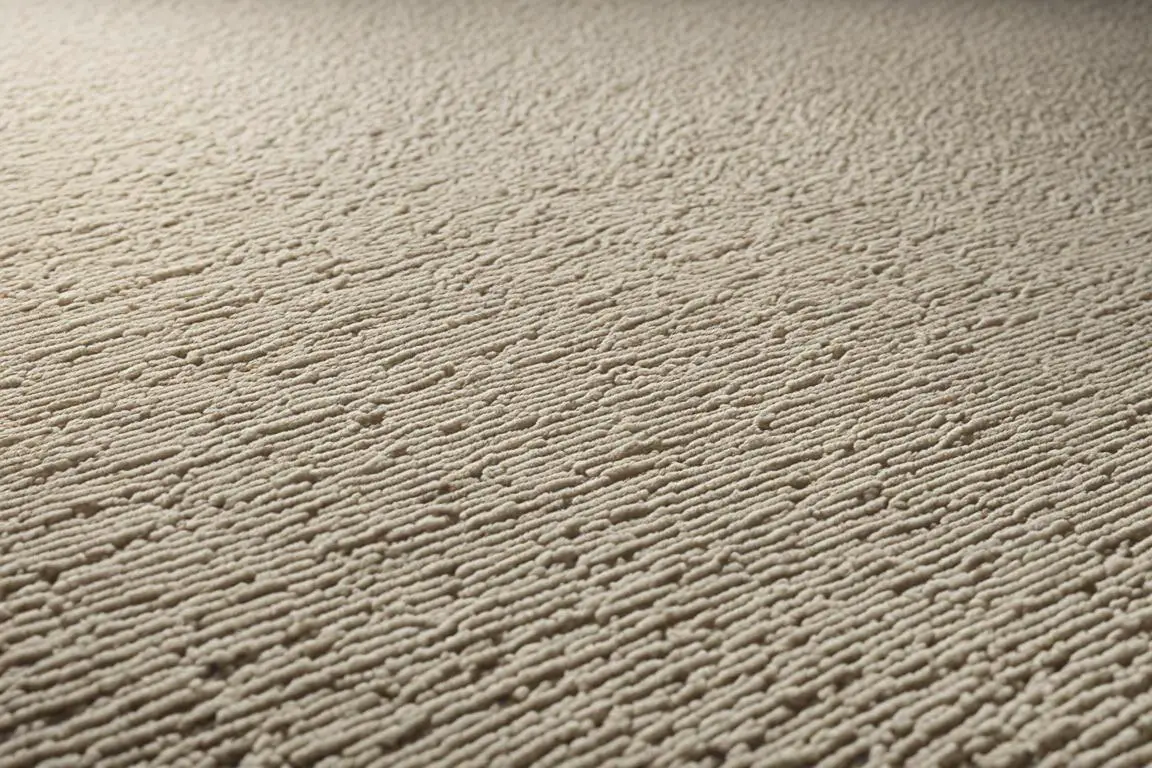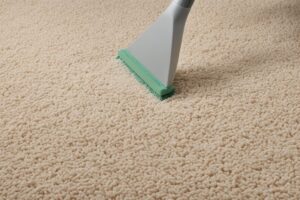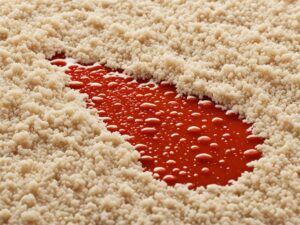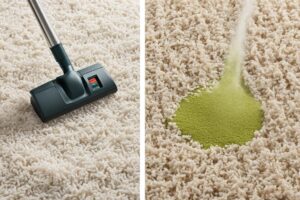Asbestos carpet glue is a type of adhesive used in the installation of carpets. It contains a mixture of adhesive materials, fillers, and tiny asbestos fibers. These fibers are so small that they cannot be easily detected by the naked eye. Therefore, identifying asbestos carpet glue based on appearance alone can be challenging.
To determine if your carpet glue contains asbestos, it is important to consider the age of the carpet and consult certified experts who can conduct professional testing in specialized laboratories. These experts have the knowledge and equipment needed to accurately identify the presence of asbestos fibers in the carpet glue.
While visual characteristics of asbestos carpet glue may not be discernible, there are other signs that could indicate the presence of asbestos, such as the age of the carpet. Carpets installed before the late 1980s are more likely to contain asbestos. However, professional testing is crucial to obtain reliable results.
Remember, identifying asbestos carpet glue requires specialized knowledge and equipment. It’s essential to seek professional assistance to ensure accurate testing and to establish appropriate safety measures.
Key Takeaways:
- Asbestos carpet glue cannot be easily identified based on appearance alone.
- Professional testing conducted by certified experts is necessary to accurately determine the presence of asbestos fibers.
- Carpets installed before the late 1980s are more likely to contain asbestos.
- Handling suspected asbestos-containing materials requires caution and professional guidance.
- Consulting experts ensures proper testing, safety measures, and appropriate removal and disposal of asbestos materials.
The Use of Asbestos in Carpet Glue
Asbestos, a heat-resistant and durable material, was commonly used in carpet glue to provide strength and ensure secure attachment of the carpet to the floor.
However, the use of asbestos in carpet installation has a dark history. The fibers of asbestos, a mineral that occurs naturally, were woven into carpet glue to enhance its performance and longevity.
Asbestos fibers in carpet glue were beneficial for their fire-resistant properties, making them ideal for buildings in need of superior flame retardant capabilities.
Unfortunately, the use of asbestos in carpet glue has been linked to numerous health risks. When disturbed, tiny asbestos fibers can become airborne and easily inhaled, leading to serious health complications.
Asbestos fibers, once inhaled, can accumulate in the lungs over time and cause diseases such as lung cancer, mesothelioma, and asbestosis.
Due to the well-documented dangers associated with asbestos exposure, many countries, including the United States, have implemented strict regulations and banned the use of asbestos in construction materials, including carpet glue.
Although the use of asbestos in carpet glue is now prohibited, it is important to understand the historical significance and potential risks associated with older carpet installations.
Signs That Indicate Asbestos Carpet Glue
While visual inspection alone is not sufficient to confirm the presence of asbestos in carpet glue, there are some signs that might indicate its presence. These include:
- The age of the carpet: Carpets installed before the late 1980s are more likely to contain asbestos. The use of asbestos in carpet glue was prevalent during that time.
- Visual indicators: Asbestos carpet glue may have a dried and brittle appearance, often resembling a thick, black tar or putty-like substance.
However, it is important to note that visual indicators alone cannot definitively confirm the presence of asbestos. To accurately determine the presence of asbestos in carpet glue, it is crucial to consult a certified professional who can conduct comprehensive testing.
Image:
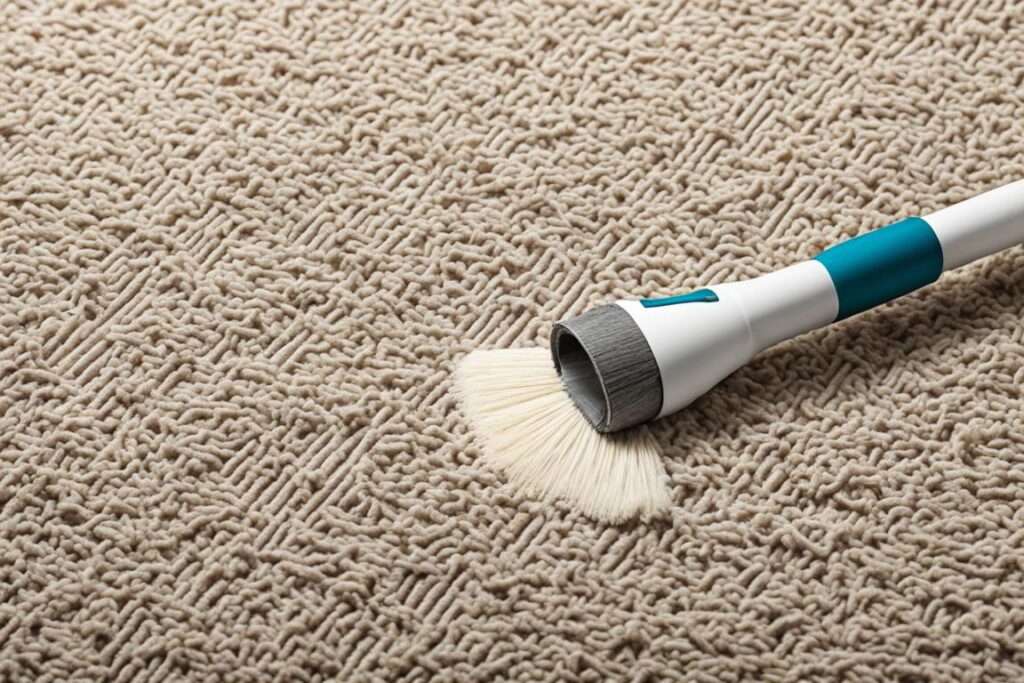
Health Risks of Asbestos Carpet Glue
Asbestos-containing materials, including carpet glue, pose significant health risks if disturbed or damaged. When asbestos fibers become airborne, they can be inhaled, leading to potential health complications such as mesothelioma, lung cancer, and asbestosis. Prolonged exposure to asbestos fibers is particularly dangerous.
Asbestos-related diseases, such as mesothelioma, lung cancer, and asbestosis, can take decades to develop after initial exposure. These diseases are often difficult to diagnose and have poor prognosis. The dangers of asbestos exposure underline the importance of taking proactive measures to minimize the risk.
Dangers of Asbestos Exposure
Exposure to asbestos fibers can have severe consequences on respiratory health. When inhaled, these fibers can become lodged in the lungs, causing inflammation, scarring, and the development of asbestos-related diseases.
It is estimated that each year, at least 2,500 Americans are diagnosed with mesothelioma, a rare and aggressive cancer that is primarily caused by asbestos exposure. Additionally, lung cancer and asbestosis are more commonly associated with asbestos exposure, highlighting the need for caution and protective measures.
Prolonged exposure to asbestos fibers presents an increased risk of developing asbestos-related diseases. The longer an individual is exposed, the higher the likelihood of developing serious health complications.
Handling Asbestos-Containing Materials
Given the health risks associated with asbestos carpet glue, it is crucial to handle any suspected asbestos-containing materials with extreme caution to prevent fiber release.
Here are some precautions to take when dealing with asbestos-containing materials:
- Do not disturb suspected asbestos materials unnecessarily.
- Avoid sanding, drilling, or scraping materials that may contain asbestos.
- If a suspected material is damaged or deteriorating, seek professional assistance for safe removal and disposal.
- Ensure proper personal protective equipment (PPE) is worn when handling asbestos materials.
- Keep work areas well-ventilated to minimize the concentration of airborne asbestos fibers.
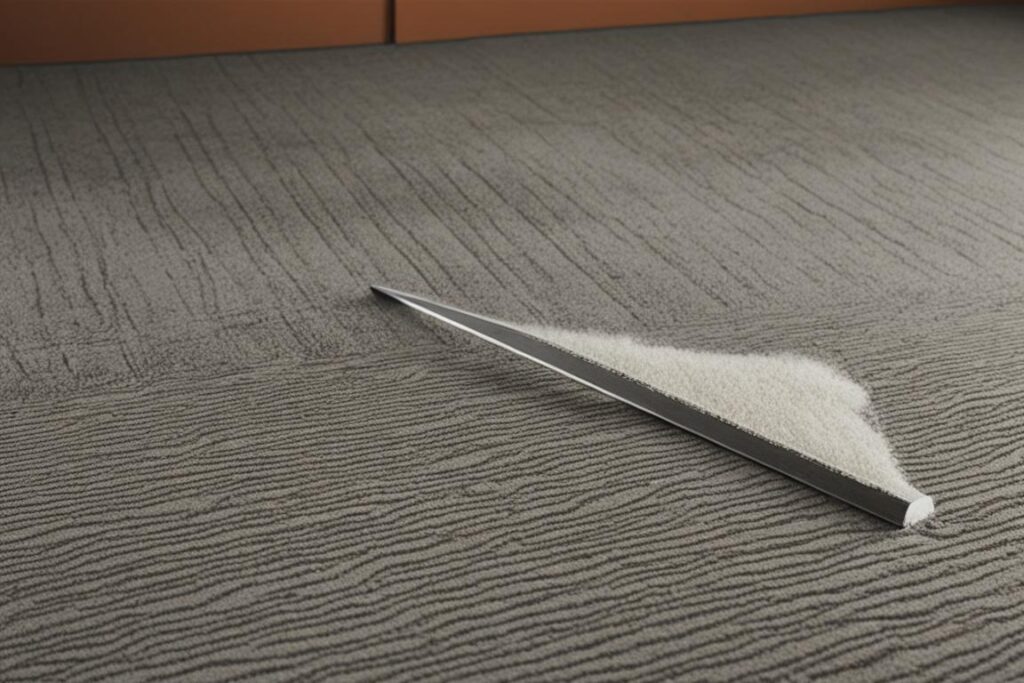
Ensuring Safety and Professional Assistance
If you suspect that your carpet contains asbestos carpet glue, it is crucial to prioritize the safety of yourself and your loved ones. Handling asbestos-containing materials without proper knowledge and precautions can pose significant health risks. To ensure a safe environment, it is highly recommended to seek professional assistance from certified asbestos professionals.
Professional asbestos testing is an essential step in identifying the presence of asbestos fibers. These experts have the necessary training, knowledge, and equipment to conduct thorough inspections and accurate testing. By relying on their expertise, you can obtain reliable results that inform the appropriate course of action.
Safe asbestos removal is a complex process that requires specialized skills and equipment. Certified asbestos professionals are trained in the proper techniques of containment, removal, and disposal, ensuring minimal fiber release and preventing further contamination. They adhere to strict safety guidelines, protecting both you and the environment.
By enlisting the services of certified asbestos professionals, you can have peace of mind knowing that every measure has been taken to safeguard your well-being. With their expertise, they will implement the necessary precautions throughout the entire process, minimizing the risks associated with asbestos exposure.
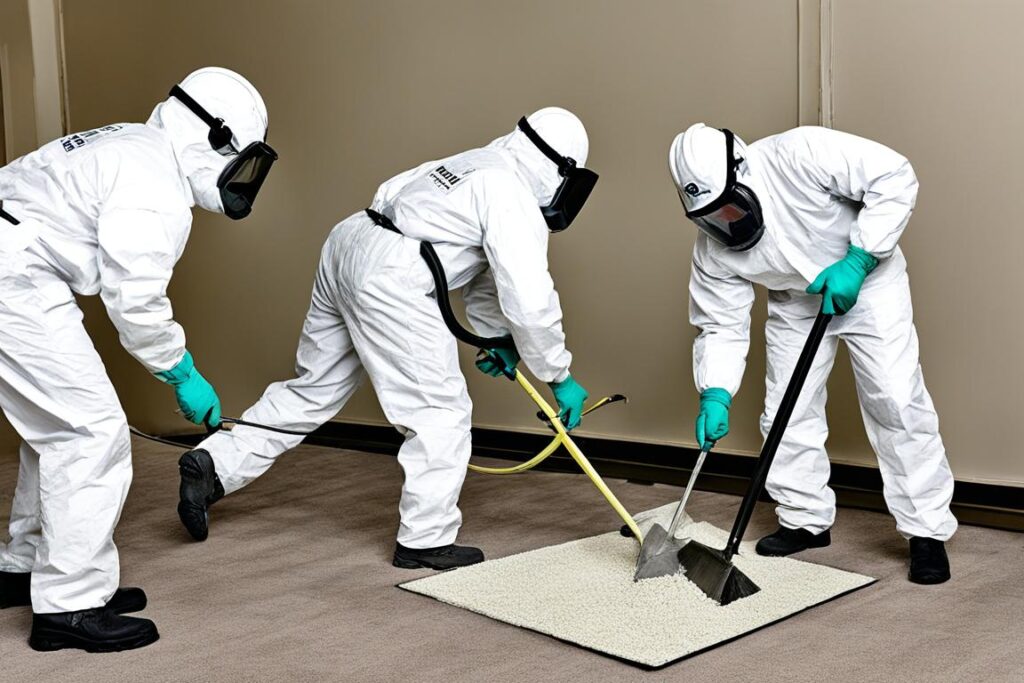
Benefits of Professional Asbestos Testing and Removal
Here are the advantages of relying on certified asbestos professionals:
- Expert knowledge: Certified professionals have in-depth knowledge of asbestos, its properties, and potential hazards. They can identify asbestos-containing materials accurately.
- Accurate testing: Professionals conduct thorough and precise asbestos testing in specialized laboratories. This ensures reliable results and eliminates any uncertainties.
- Safe handling: Asbestos professionals have the necessary training and equipment to safely handle asbestos materials, minimizing the risk of exposure.
- Containment and removal: Professionals implement proper containment measures to prevent fiber release and follow strict protocols for asbestos removal.
- Disposal: Certified professionals dispose of asbestos materials in compliance with local regulations, preventing further contamination and environmental harm.
Remember, when it comes to your health and safety, it is crucial not to take any chances. Always rely on the expertise of certified asbestos professionals for professional asbestos testing and safe asbestos removal.
Identifying Asbestos Glue
When it comes to identifying asbestos glue, one common name comes to mind – black mastic. Asbestos glue, also known as black mastic, is a type of adhesive commonly found under older vinyl tiles and floors. It exhibits distinct characteristics that can help in its identification.
Asbestos glue has a unique appearance and consistency that sets it apart. It typically has a dried putty-like texture that feels slightly tacky or springy to the touch. This characteristic consistency is one of the visual properties that can help in identifying asbestos glue.
Characteristics of Asbestos Glue:
- Color: Asbestos glue is usually dark brown or black in color. This coloration can be a significant visual indicator when examining flooring materials.
- Consistency: The dried putty-like consistency of asbestos glue makes it stand out among other adhesives. It is not overly rigid, giving it a slight flexibility that can be observed upon touch.
It’s important to note that while visual identification can provide some clues, professional testing is crucial to confirm the presence of asbestos in glue. Asbestos fibers in glue and other materials are microscopic, making them impossible to detect without specialized laboratory analysis.
Understanding the identifying characteristics of asbestos glue can help create awareness and facilitate informed decision-making. It is always recommended to consult certified professionals when dealing with suspected asbestos-containing materials to ensure the safety of yourself and others.
Risks and Precautions When Dealing with Asbestos Glue
Asbestos glue can pose risks to human health if handled improperly. While undisturbed asbestos glue may not immediately endanger your well-being, it becomes hazardous when the glue or the flooring beneath it gets damaged or torn. In such cases, asbestos fibers can be released into the air, increasing the potential for exposure. To ensure your safety and the safety of those around you, it is crucial to take necessary precautions when dealing with asbestos glue.
Health Risks of Asbestos Glue Exposure
Exposure to asbestos fibers released from damaged or disturbed glue can lead to serious health issues. Inhaling these tiny asbestos fibers can result in diseases such as mesothelioma, lung cancer, and asbestosis. These illnesses often take years or decades to manifest and can have severe long-term effects on your respiratory system. It is important to be aware of the risks associated with asbestos glue exposure and take appropriate measures to mitigate them.
Precautions for Handling Asbestos Glue
When working on carpets or any area potentially containing asbestos glue, it is vital to follow proper safety protocols. Here are some essential precautions to consider:
- Consult professionals: It is recommended to seek professional assistance for testing, removal, or repair of asbestos-containing materials. Certified experts have the experience and knowledge to handle asbestos safely and minimize the risks of exposure.
- Avoid DIY removal: DIY removal of asbestos glue is strongly discouraged due to the high risk of fiber release. Disturbing the glue without proper containment measures can lead to the spread of asbestos fibers throughout your home, endangering your health and the health of others.
- Use protective gear: When working with asbestos glue or during any activities that may disturb it, wear personal protective equipment (PPE) such as disposable coveralls, gloves, respirators, and safety goggles. This gear helps reduce the chances of inhaling or coming into direct contact with asbestos fibers.
- Minimize dust and debris: Take steps to minimize the generation of dust and debris during any work involving asbestos glue. Use wet methods, such as misting with water, to suppress dust. Additionally, ensure proper containment and clean-up of any waste or materials contaminated with asbestos fibers.
- Follow local regulations: Familiarize yourself with relevant local regulations and guidelines regarding asbestos handling, removal, and disposal. Adherence to these regulations is critical to ensuring the safety of yourself, your family, and the environment.
By following these precautions and seeking professional assistance, you can minimize the risks associated with asbestos glue exposure and ensure a safer environment for everyone involved.
| Precautions for Handling Asbestos Glue | Benefits |
|---|---|
| Consult professionals | Ensure safe handling, testing, and removal of asbestos glue |
| Avoid DIY removal | Prevent the release of asbestos fibers and potential contamination |
| Use protective gear | Reduce the risk of inhalation or direct contact with asbestos fibers |
| Minimize dust and debris | Prevent the spread of asbestos fibers throughout the environment |
| Follow local regulations | Ensure compliance with safety guidelines and protect the environment |
Conclusion
Identifying asbestos carpet glue appearance is not a task for amateurs. It requires professional testing and consultation to accurately determine the presence of asbestos fibers. Older carpets, particularly those installed before the late 1980s, are more likely to contain asbestos. Therefore, it is essential to exercise caution when handling suspected asbestos-containing materials and seek expert assistance for safe removal and disposal.
By understanding the appearance and characteristics of asbestos carpet glue, homeowners can take proactive measures to maintain a safe and asbestos-free environment in their homes. Regular inspections, especially for older carpets, can help identify potential risks and enable timely action to be taken. Remember, the safety of your family and loved ones should always be the top priority when dealing with asbestos.
Always consult certified professionals who specialize in asbestos testing and abatement. Their expertise ensures that proper procedures are followed to minimize any potential health hazards associated with asbestos exposure. By working with professionals, you can have peace of mind knowing that your home is being handled safely and responsibly.
FAQ
What does asbestos carpet glue look like?
Asbestos carpet glue, also known as black mastic, has a dried putty-like consistency that is slightly tacky or springy. It is typically dark brown or black in color.
How can I identify asbestos carpet glue?
Identifying asbestos carpet glue requires professional testing and consultation. However, some signs that might indicate its presence include the age of the carpet, as carpets installed before the late 1980s are more likely to contain asbestos. It is crucial to handle any suspected asbestos-containing materials with caution and seek professional assistance for safe removal and disposal.
What are the health risks of asbestos carpet glue?
Asbestos-containing materials, including carpet glue, pose significant health risks if disturbed or damaged. When asbestos fibers become airborne, they can be inhaled, leading to potential health complications such as mesothelioma, lung cancer, and asbestosis. Prolonged exposure to asbestos fibers is particularly dangerous.
How can I ensure safety when dealing with asbestos carpet glue?
If you suspect that your carpet contains asbestos carpet glue, it is highly recommended to seek professional assistance. Certified experts can conduct thorough testing to determine the presence of asbestos fibers. Professional asbestos abatement services ensure safe handling, containment, and proper disposal of asbestos materials, prioritizing the well-being of everyone involved.
What does asbestos glue look like?
Asbestos glue, commonly known as black mastic, has a dried putty-like consistency that is slightly tacky or springy. It is typically dark brown or black in color. Asbestos glue is commonly found under older vinyl tiles and floors.
What are the risks involved in dealing with asbestos glue?
Asbestos glue, when undisturbed, may not pose an immediate health threat. However, if the glue or the flooring underneath it becomes damaged or torn, asbestos fibers can be released into the air. It is essential to consult professionals when working on your carpet to minimize the risk of exposure. DIY removal or disturbance of asbestos glue should be avoided.
